

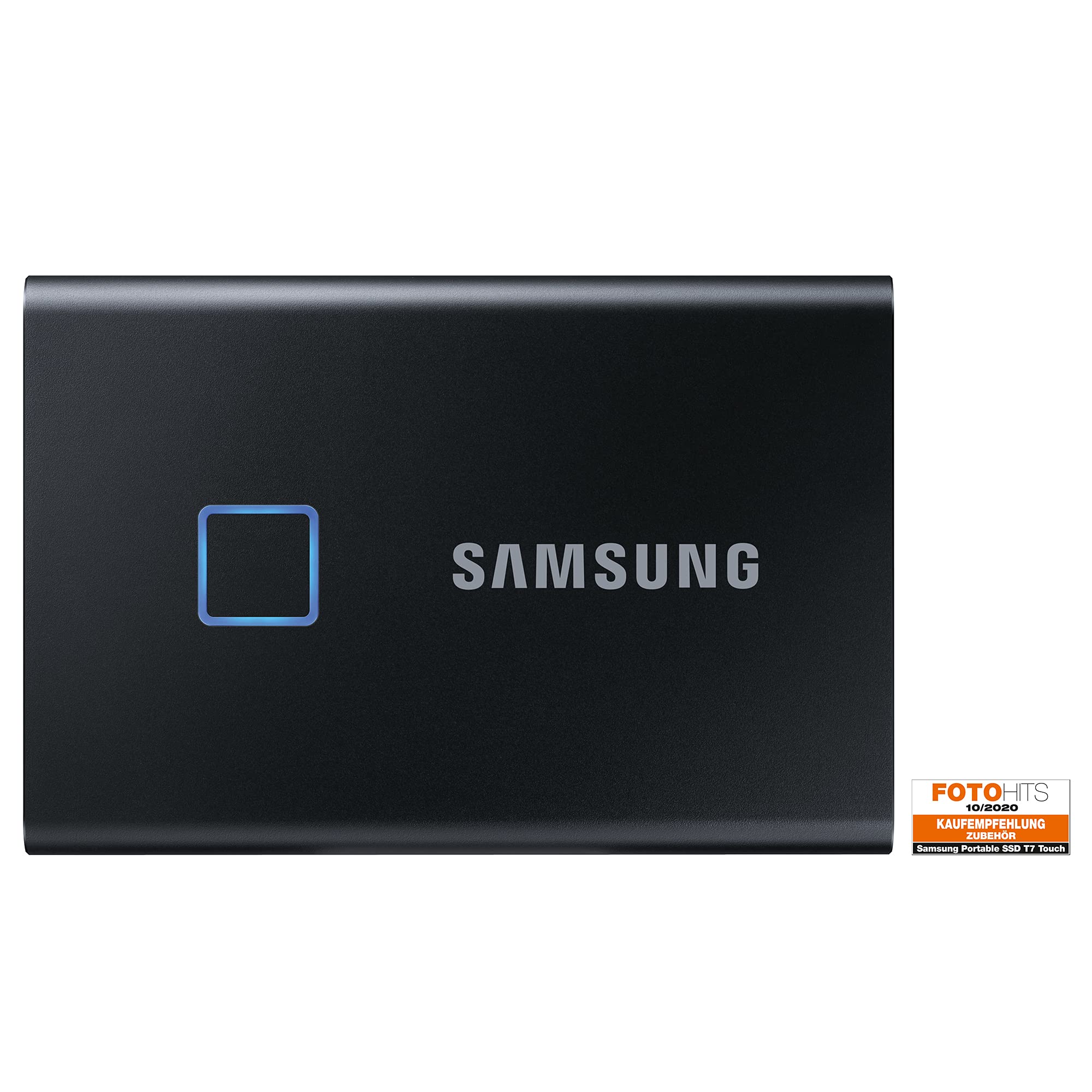
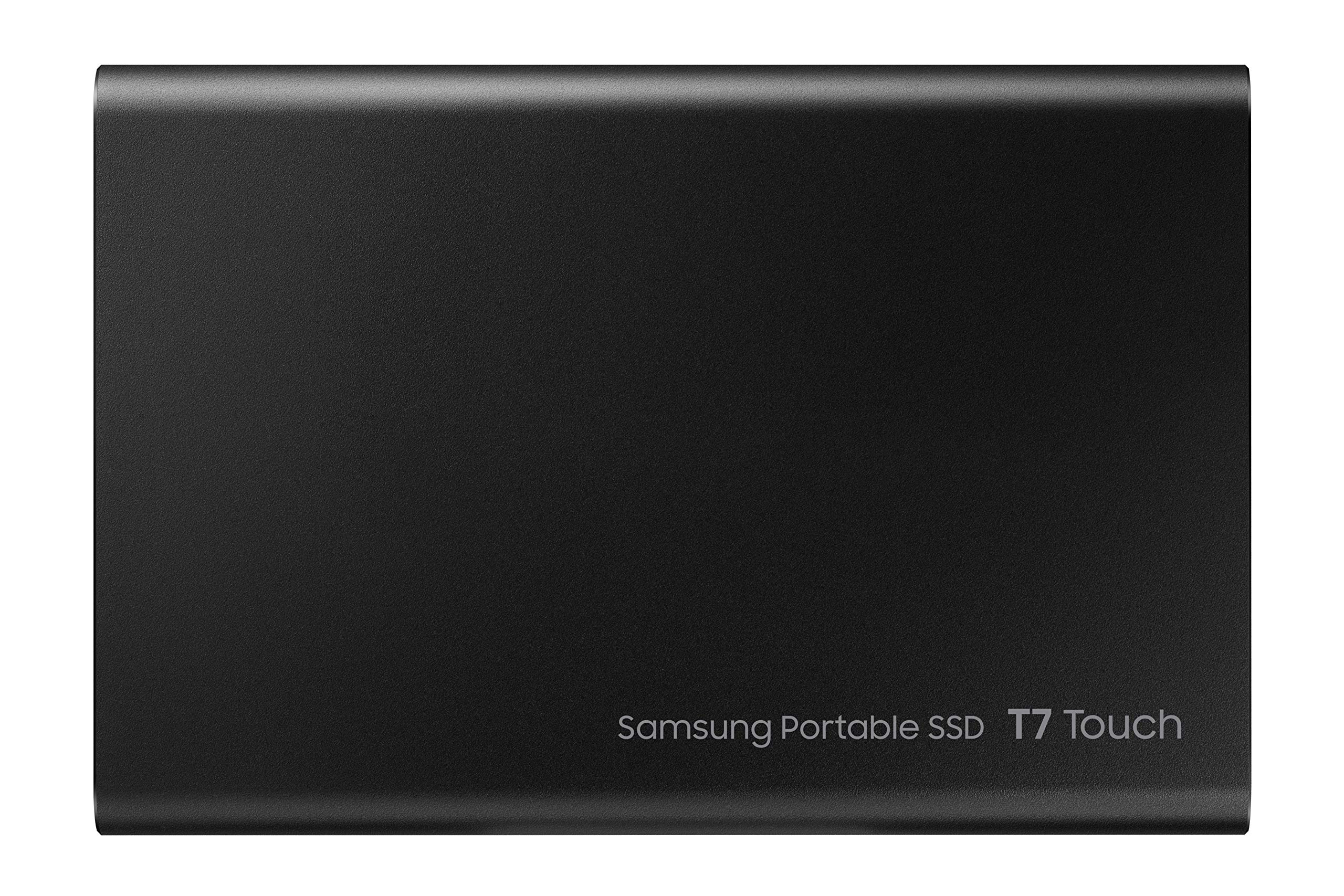
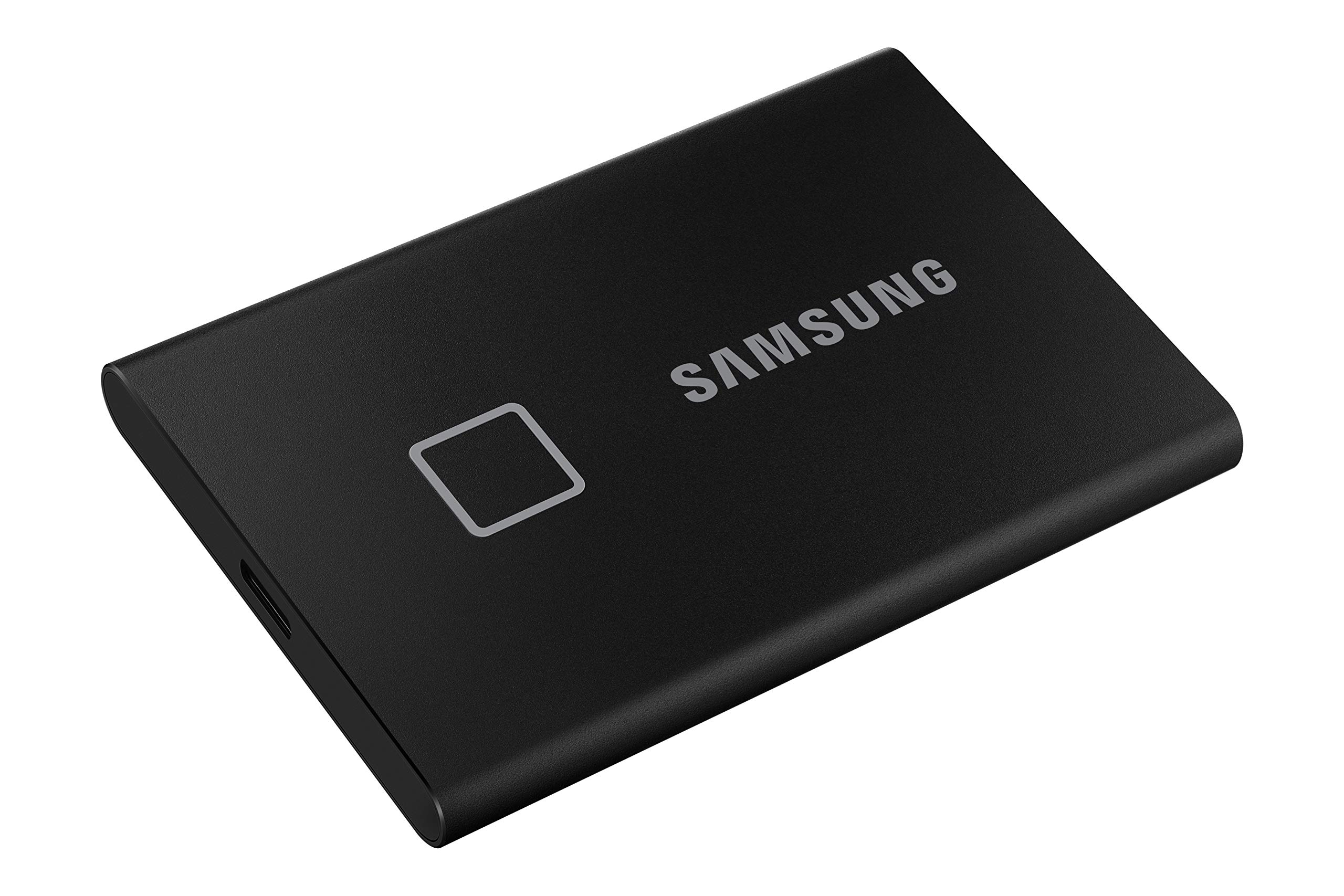
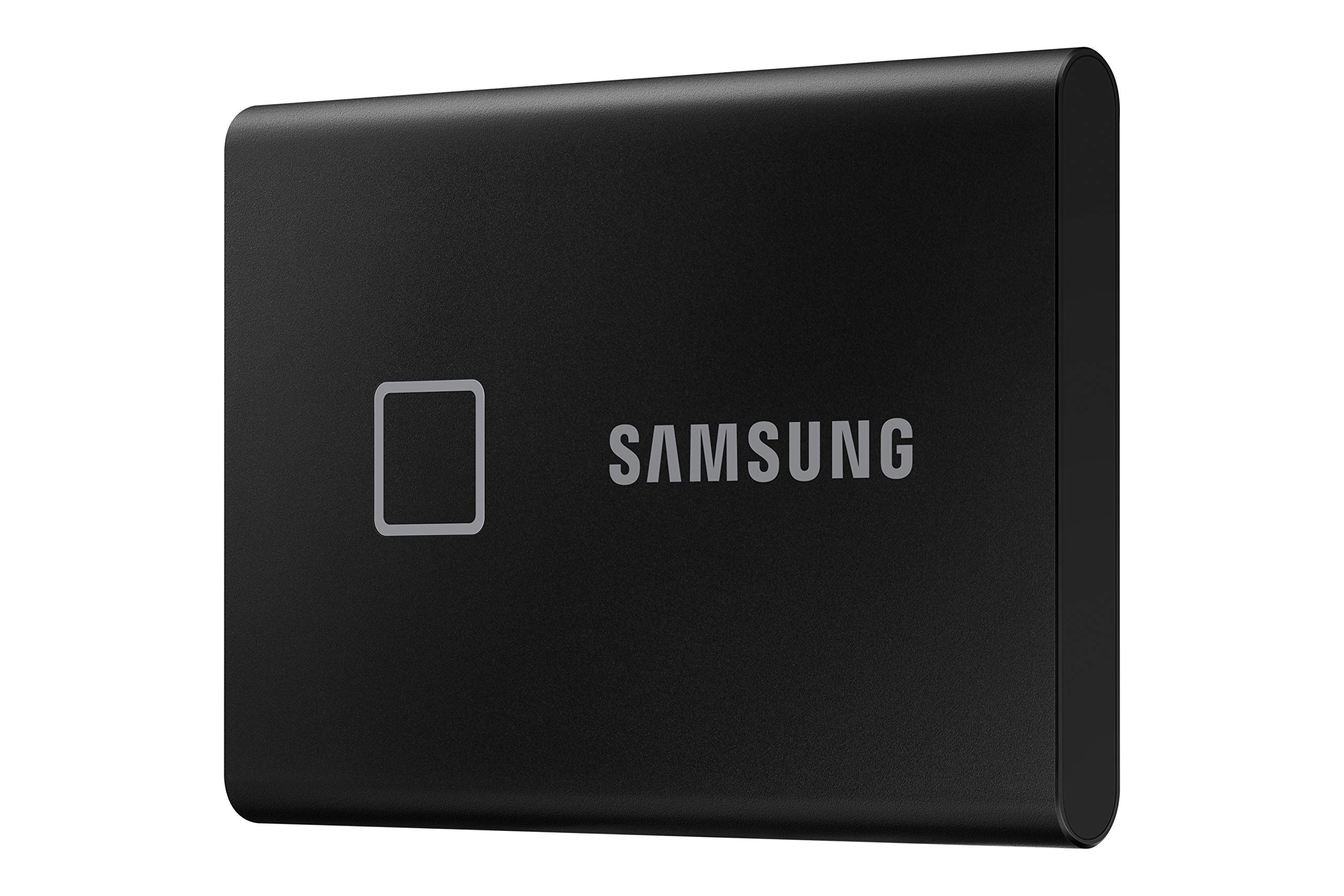
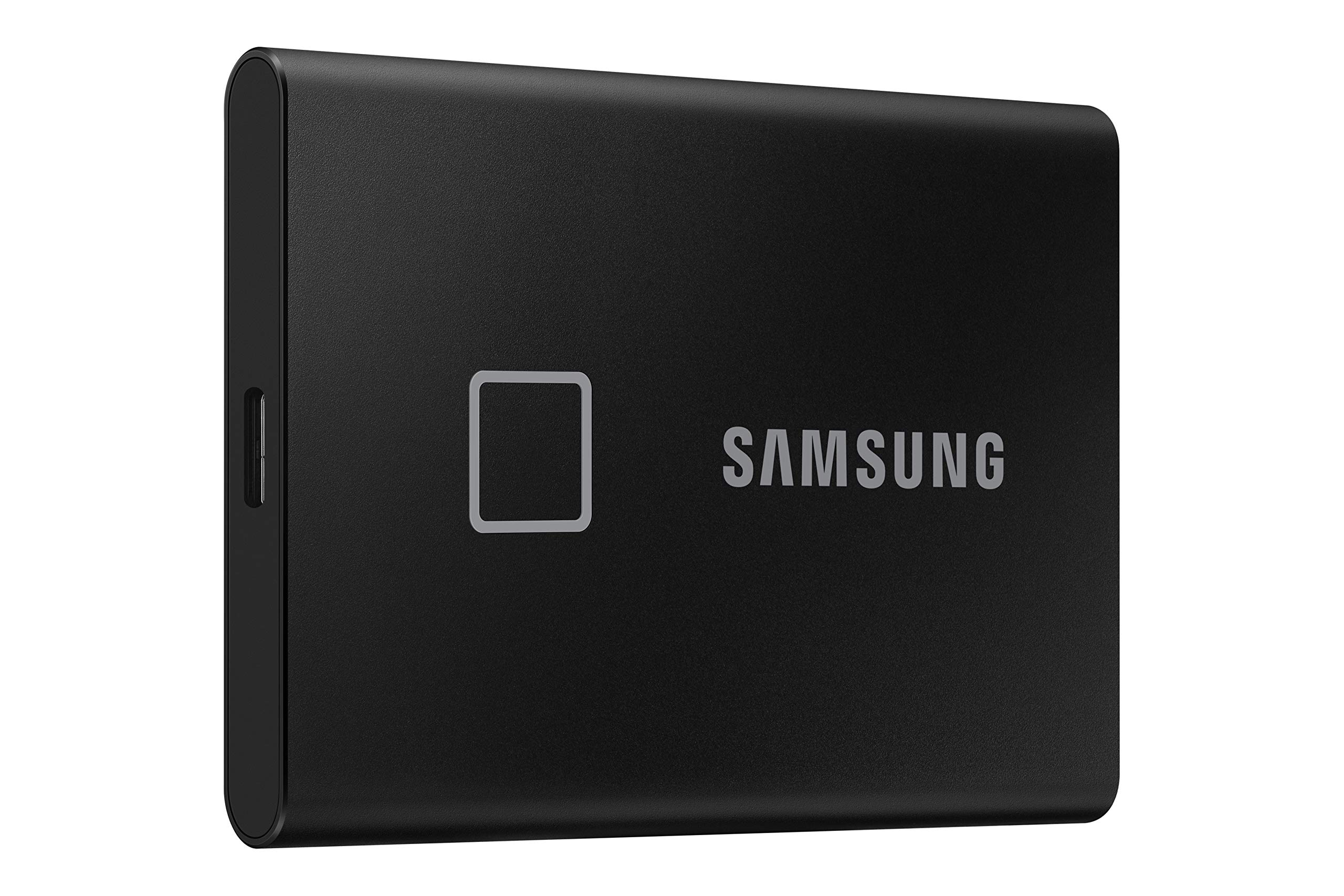
Samsung T7 Touch 2TB Up to 1,050MB/s USB 3.2 Gen 2 (10Gbps, Type-C) External Solid State Drive (Portable SSD) Black (MU-PC2T0K)
| Standing screen display size | 16 Inches |
| Hard Drive | 2 TB Solid State Hard Drive |
| Brand | Samsung |
| Series | T7 Touch |
| Item model number | MU-PC2T0K/WW |
| Hardware Platform | Mac, PC |
| Item Weight | 2.05 ounces |
| Product Dimensions | 3.35 x 2.24 x 0.31 inches |
| Item Dimensions LxWxH | 3.35 x 2.24 x 0.31 inches |
| Color | Black |
| Flash Memory Size | 2 MB |
| Hard Drive Interface | USB 3.2 |
| Manufacturer | Samsung |
| Language | English, English, English, English, English |
| ASIN | B082VVV926 |
| Is Discontinued By Manufacturer | No |
| Date First Available | January 9, 2020 |
A**J
My earlier review was not totally correct.
Your browser does not support HTML5 video. Everything in the old review is accurate, but only for the default format you get the drive in- EXFAT. I have changed it to Mac OS Extended and NTFS and it works amazing in both formats, never faced that force eject issue. I was wrong about speeds too. They are more faster now. Actually for larger files, earlier, it was about the same speed as of my WD hard drive with moving parts(i.e, not ssd), when T7 was in EXFAT. I do not know why EXFAT was not working in MacOS, cause I have other drives (non-ssd) with EXFAT and they seem to work fine. After changing the format, the speeds are way better for any file size.EXFAT works with both MacOS and NTFS without an issue. You cannot use the drive in MacOS without additional software, if you are using NTFS partition(mostly not free if you are using multiple drives with NTFS). Vice versa with windows if you are using Mac OS extended. I think it might be a software issue rather than a hardware one thatEXFAT is not working and hope they fix it. I have tried with EXFAT in two MacBook pro's and it was the same issue. I have also tried with two different T7's(I got one replaced thinking it might have been a defected piece), but there were the same issues again.Old Review:I have got this 5 days back. It started behaving weirdly since 2 days. It always asks me to 'force eject'(Attached a video). It says other program is using it, even though there is no background app running other than Samsung ssd's app, I even closed that and it's the same result. Suddenly yesterday after unlocking with fingerprint the drive itself was not being shown. It happened for a long time like that. When I insert, it shows the read only disk(which won't have my files as it is expected to), but when I unlock it, it doesn't show the disk with my files. luckily it shown afterwards, I donot exactly remember what I did, I think I erased it for it to work. luckily I had a backup. I wanted to use this with very important and confidential documents and wanted to store them only here and nowhere else. I wouldn't have done that with any other drive, coz it's risky. This thing started malfunctioning too early and I cant even return my product, the only option is to replace, which I don't want cause I do not want to risk it again.It is very portable and speeds are decent(actually very good considering the portability factor and way better than any hard drives with moving parts, coz it's an ssd), fingerprint works well, all these are of no use if it just stops working and you lose all your important data which you can't recover.
D**A
Waaah mast hai
Fingerprint security is must love it, lightweight & smarter, remember its 3.2 comparable hub ,feels veryhot in between file transfer between 3.0 hub and t7 very very hot , 6.3 Gb file transfer time between oneplus 7t and samsung t7 is 0:50:67 sec very impresive but very hot at this time oneplus 7t with 3.0 hub think thats the cause of heat, file transfer between oneplus 5 they have 2.0 hub about 3.5 Gb file in 2min15sec thats means data transferred is differ . So clearly knows that your divice is handle the transfer capacity . Before you buy the product you knows about your device capecity like usb 2.0 or 3.0 or 3.1 or that have 3.2 type C support hub if your device have 3.0 or 3.1 c type hub so you go for samsung t5 ssd if they have 3.2 naturally go for t7ssd if you are looking for future go for t7 but after 1 or 2 years price is difference .
K**R
It's a hit or miss
While copying video files it has an impressive speed of 500mbps but if I go on to copy software or a program like Unreal engine initially the speed is 300mbps but then it drops down to 4-5 Mbps.The second picture shows the comparison between PSSD T7 touch and WD HDD while copying a 30.3 GB file.
A**A
Excellent product.
wow !! excellent!!! Great Product and accurate with what adoffers. I recommend to other buyers with confidence !!! Great job friend!!!! Yeayyyyyyyyyyyyyyyyyyyyyyyyyyyyyy!!'Hoooooo Hoooooooo Hooooooooo!!! Reorder coming your way!!l
A**I
Heating badly... working fine with MacBook 💻 pro (MacOS Big sur 11.2.1)
The first time you are to install the software it prompts you to go to System Preferences > Security & Privacy and under the General tab you are to find a Notification under the "Allow apps downloaded from:" section. If you miss that at the first installation it will never appear again unless you switch macOs in recovery mode and disable kernel extensions blocking. Unistall the Samsung Portable SSD utility using the script inside the Application contents. Follow the guidelines in the medium article to disable the feature mentioned above. Then reinstall the Samsung Portable SSD utility and you will get the notification saying the extension has been blocked. Click on go to Security & Privacy settings and under The General tab you will see the text I described earlier. Unlock the settings and click on details. Tick on Samsung Electronics close the details window and restart your Mac as prompted. Then, remove your Samsung Portable SSD and open the Samsung Portable SSD utility. Connect your SSD press refresh and you should be fine. Lastly, reboot to recovery mode and enable the kernel extensions blocking feature.
N**N
Doesn't work with macbook with Big Sur
After looking at so many positive reviews of T7 around the different platforms, I decided to give it a shot. I have a windows laptop and a macbook with M1 chipset and macOS Big Sur. I installed the software which was given in the SSD itself, but to my surprise, the software didn't recognise the SSD. It kept on showing that the SSD has not been detected. Surprisingly when I connected the SSD to the windows laptop, it worked perfectly fine with password and fingerprints enabled.After searching the issue on Samsung and apple community platform, I found that most of the users are facing the same issue.The problem lies with security software which has to be installed for password protection. Samsung has given any software update in 3 months even when it knows that every user of mac with Big Sur is facing this issue. Even there customer executive doesn't have any idea as to how to resolve this issue.CONCLUSION - Don't buy it if you have MacBook with macOS Big Sur. It won't work for sure. Eventually, you will have to return it. Go for some other brand.For every other user other than mac with Big Sur, this is the best SSD you can invest your money on. Light in weight, sleek design, high read and write speed.. go for it without a second thought.
N**O
Eine perfekte Weiterentwicklung
Your browser does not support HTML5 video. Am 22.08.2018 veröffentlichte ich meine Rezension zur Samsung SSD T5. Ich war damals sehr begeistert von der Perfektion und bin es auch heute noch. Nun halte ich jedoch den Nachfolger - die T7 - in den Händen. Ich möchte hiermit meine Einschätzung zum Nachfolger abgeben.Aufgrund der als sehr positiv bewerteten Rezension werde ich diese übernehmen und lediglich an den Stellen anpassen, an denen sich etwas verändert hat.Rezension:Ich bin technisch sehr versiert und baue auch meine PCs selbst zusammen. In all den Jahren habe ich eins gelernt:Wer Leistung will, muss dafür auch bezahlen.Für alle, die vor der Fragen stehen, ob sie sich diese SSD kaufen sollen:Samsung ist in vielen Bereichen gut, neben dem Smartphone-Sektor ist Samsung aber vorallem im Bereich der SSDs der Marktführer. Das liegt daran, dass Samsung die SSD-Technik mit hohem Einsatz vorantreibt und anderen Unternehmen oft um Jahre voraus ist.Und dies zeigt sich auch in der nun mittlereile 4. Generation der T-Serie - und damit zum Produkt.Die Samsung T7 ist etwa so groß wie eine EC-Karte, ist spielend leicht und besteht (das Gehäuse betreffend) vorwiegend aus Metall. Gegenüber dem Vorgänger T5 ist die T7 etwas länger, dafür aber auch flacher geworden. Zudem fühlt sich das Metallgehäuse noch wertiger an. Die SSD ist in den Größen 500GB, 1TB und 2TB verfügbar. Alle drei Varianten sind in schwarz und silber erhältlich. Es ist nicht unwahrscheinlich, dass Samsung wie bei der T5 weitere Farben nachgelegt. Die T7 verfügt über einen USB 3.1 Gen2 Anschluss mit USB-C Stecker. Damit ist die T7 auf dem heutigen Stand der Technik. Um die Verwirrung um USB aufzulösen:USB 3.1 (= USB 3.0) = 5 Gbit/s.USB 3.1 Gen2 = 10 Gbit/sUSB 3.1 Gen2x2 (noch nicht auf dem Markt) = 20 Gbit/sIn der Namensgebung ist auch USB 3.2 Gen2x2 für die letztere Version möglich.Die T7 arbeitet über einen Controller, der PCIe NVME in USB umwandelt. Somit umgeht Samsung endlich den Flaschenhals des SATA III Controllers der T5. Die T7 wird somit durch den USB Port limitiert. Der Nachfolger dürfte dank USB 4.0 doppelt so schnell sein. Der USB Port schafft Netto 1250 MB/s, wovon die T7 1050 MB/s erreichen soll. Diese Angaben beziehen sich stets auf die Lesegeschwindigkeit. Diese Geschwindigkeiten erreicht die T7 auch durchaus. Die Differenz von 200 MB/s entstehen durch normale, technische Verluste und wahrscheinlich der Tatsache, dass NVME Controller noch relativ neu sind. Mit der X5 hat Samsung bereits gezeigt, wo die Zukunft hingeht.Leider gibt es die T7, wie schon die T5, mit maximal 2TB. Dadurch sind die Preise pro GB nicht allzu stark gesunken. Die T7 kostet aktuell etwa 145€ für 500GB. Die T5 liegt bei 90€, allerdings mit technischen Einbußen. Somit ist der Preis mehr als akzeptabel, da es keine vergleichbaren externen SSDs gibt. Interne SSDs sind jedoch schon deutlich günstiger zu haben. So bekommt man 1TB (Samsung 860 Evo) bereits für 150€. Diese ist auf dem Niveau der T5 und ist seit damals um 50€ billiger geworden.Wer eine feste SSD für einen PC sucht, sollte also zur 860 Evo greifen oder als Pendant zur T7 eine NVME SSD einbauen. Hier erreicht Samsung jedoch bereits das dreifache der T7. Für alle, die ein portables Speichermedium suchen, finden mit der T7 das Non-Plus-Ultra im Jahr 2020.Dies ist auch auf die zweitwichtigste Neuerung zurückzuführen. Die Samsung T7 verfügt über eine AES 256-bit Verschlüsselung, welche die privaten Daten schützt. Zudem lässt sich nicht nur ein Passwort hinterlegen, sondern auch bis zu 4 Fingerabdrücke. Der hardwareseitige Fingerabdruckscanner arbeitet extrem präzise und schnell. Hier kann Samsung offensichtlich auf Erfahrung aus dem Smartphonesegment zurückgreifen. Die Installation ist binnen 1-2 Minuten komplett abgeschlossen.Clever: Um den Sensor befindet sich ein LED-Ring, welcher blau zur Bestätigung leuchtet und im Uhrzeigersinn durchläuft, wenn die SSD Daten verarbeitet.Die Kapazität entspricht den angegebenen Werten. Achtung, Windows verwendet die Größe GibiByte (1024 statt 1000 MB pro GB). Dadurch wird die SDD in Windows als kleiner angezeigt.Wer also Leistung will, sollte zur T7 greifen, wer weder aktuelle USB Ports besitzt, noch einen Fingerabdruckscanner benötigt, kann getrost zur T5 greifen. Gerade als Speichermedium für ältere Spielekonsolen kann sich die T5 noch lohnen. Es gibt bei beiden SSDs keine negativen Punkte zu beachten.An Bord ist bei Kauf die Passwort-Software, ein USB-C zu USB-C Kabel, sowie ein USB-C zu USB-A Kabel.P.S.Leider wurden die Speedtests nicht in meine Cloud geladen, weshalb ich keine Speedtests für den USB Port mit 10 Gbit/s eingefügt habe. Diese versuche ich zeitnah nachzureichen.Edit: Ich habe die Datenraten für USB 3.1 Gen2 nun für euch hinzugefügt. Wie zu erwarten war, schafft die "kleine" 500GB Version die 1050 MB/s lesend nicht. Für die größeren Varianten erscheint dies jedoch aufgrund der guten Datenrate machbar.
T**U
Sehr gut als externer Speicher für die Playstation 5
Your browser does not support HTML5 video. Produkttest: Samsung T7 Touch Portable SSD - 1 TBAusgangslage bzw. Einsatzbereich:Ich hatte das Glück eine Playstation 5 zu bekommen. Leider ist der freie Speicherplatz der internen SSD der PS5 ca. 600 GB welcher für Spiele oder Apps zur Verfügung steht. Bei der heutigen Größe der Spiele wird der Speicher da relativ schnell knapp werden. Ich habe deshalb die Samsung T7 Touch Portable SSD mit 1 TB bestellt um sie als externen Speicher für die PS5 zu verwenden. Auch wenn aktuell darauf nur PS4 Spiele ausgelagert bzw. installiert werden können bleibt mir damit ja mehr freier Speicher auf der internen SSD der PS5.Verpackung, Inhalt und optischer Eindruck des Produktes:Die externe SSD kommt in einer kleinen Verpackung. In der Verpackung sind 2 Kabel für den Anschluss der SSD auf USB-C oder USB-A vorhanden. Zusätzlich liegt noch eine kleine Minibeschreibung bei. Optisch wirkt die SSD sehr hochwertig. Sie ist gerade mal etwas größer als eine Scheckkarte.Erster Test und Eindruck:Zu Beginn habe ich die SSD mal an meinem PC über USB-C angeschlossen. Die SSD erreicht beinahe die vom Hersteller beschriebene Datenrate von 1.000 MB /s. Sie wird auch sofort ohne Probleme erkannt. Der Speedtest liefert ganz ordentliche Werte. Details sind am Screenshot zu erkennen.Danach habe ich sie gleich mal an der PS5 an einem der hinteren USB Anschlüssen angesteckt. Das Einrichten ging sehr rasch von statten. Bei meinen Test habe ich einfach 2 PS4 Spiele von der Internen SSD gestartet und die Zeit gestoppt. Danach habe ich das Spiel auf die externe SSD verschoben und wieder die Zeit gestoppt. Zu guter Letzt habe ich das Spiel dann von der externen SSD gestartet und wieder die Zeit gestoppt. Nun gut, die Ergebnisse sind wie folgt:Days Gone:Interne SSD:44,47 Sekunden bis zum Startbildschirm38,30 Sekunden bis zum SpielstartVerschieben auf externe SSD:2:14,69 Minuten für 42GBExterne SSD:45,47 Sekunden bis zum Startbildschirm35,99 Sekunden bis zum SpielstartBatman, Arkham KnightInterne SSD:42,47 Sekunden bis zum Startbildschirm22,79 Sekunden bis zum SpielstartVerschieben auf externe SSD:2:40,65 Minuten für 50,55GBExterne SSD:42,50 Sekunden bis zum Startbildschirm22,60 Sekunden bis zum SpielstartWie man sieht starten die Spiele genauso schnell auf der externen SSD wie auf der internen SSD der PS5. Somit eine perfekte Wahl um die SSD als externen Speicher zu verwenden.Hinweis: Aktuell empfiehlt es sich lt. verschiedener Foren den Stromsparmodus zu deaktivieren solange man einen externen Speicher verwendet. Hier scheint es noch Fehler in der PS5 Firmware zu geben.Fazit:Die externe SSD kann perfekt als externer Speicher der PS5 verwendet werden. PS4 Spiele werden genauso schnell von der externen SSD geladen wie von der internen der PS5. Die Probleme mit der aktuellen PS5 Firmware in Kombination mit dem externen Speicher werden hoffentlich bald von Sony behoben..Auch am PC kann die SSD ohne Probleme verwendet werden.Es gibt von mir 5 Sterne, d.h. eine klare Empfehlung der externen SSD von Samsung.Sorry für die relativ lange Rezension. Wenn Ihnen die Rezension gefallen oder geholfen hat, würde es mich freuen wenn Sie sie als nützlich bewerten würden. Vielen Dank
G**D
Gute Idee aber Hardware/Software verbuggt.Verbindungsabbrüche
Die Idee mit dem Fingerabdruck und die Umsetzung ist toll, keine Frage...ABER:Die Festplatte wurde fehlerhaft konstruiert. Diese anzubieten ist eine Unverschämtheit. Die Platte trennt beim LESEN (nicht beim schreiben!!!) größerer Datenströme einfach die Verbindung und verbindet sich dann neu oder sie stürzt komplett ab und der Explorer Prozess von Windows 10 hängt sich auf. Ich habe das auf 4 verschiedenen Computern ausprobiert und es ist überall das selbe Problem, liegt also an der Platte.Ich habe beim Samsung Support angerufen und mein Problem geschildert. Dort wurde mir gesagt ich soll die Security Optionen einmal deaktivieren und die Platte neu formatieren.Habe ich gemacht, brachte aber auch keine Besserung. Auch das Formatieren in NTFS Dateiformat brachte hier keine Abhilfe.In div Foren beschweren sich die Leute auch schon. MAC OS User haben wohl auch das selbe Problem.Das Produkt ist fehlerhaft und ich kann hier definitiv keine Kaufempfehlung aussprechen. Das geht wieder zurück nach Amazon.
W**.
T5 = sehr gut, T7 = schlecht
Klein, leicht und beim 1.Kopiervorgang (bei den ersten 200-300 GB) wie beworben, sehr schnell. Das war es dann aber auch schon, d.h. bei den weiteren Kopiervorgängen (immer von schnellem SSD-Speicher eines iMac über den Thunderbolt 3-Port) gab es z.T. Transferzeiten langsamer als bei jeder normalen USB-Festplatte. Auch mit Ausprobieren anderer Kabel hat sich an dieser „Problematik“ nichts geändert. Zudem wurde die T7 von meinem Mediaplayer am USB3-Port zwar erkannt; das Abspielen von Filmen war aufgrund extremer Wackler/Aussetzer jedoch nicht möglich - vermutlich durch ständiges, aber mangelhaftes viel zu langsames Nachladen der Streamingdaten (beginnt immer nach 50-70 Sekunden, verschwindet dann für n Minuten und tritt dann wiederholt für 60 sec und mehr immer wieder auf.Die Verschlüsselungstechnik habe ich gar nicht erst aufgerufen (Anleitung dazu lag in Form eines kleinen Heftchens nur in Englisch und Chinesisch, nicht aber in Deutsch, bei.Ich habe bereits 3 x das T5-Modell im Einsatz - ohne jegliche Probleme !!!Somit ist das T7 für mich und meine Belange absolut unbrauchbar (und gemessen daran, auch viel zu teuer).
A**E
Avoid like the plague - failed on first attempt to transfer data to it. Returned.
I needed this desperately as I am working from home. Suffice it to say it failed me.First the positives: The fingerprint ID worked well. The device is very portable, light and well built. It's also incredibly compact, but as you'll see below that might be a mixed blessing in that it heats up.And therein lies the rub. I attempted to move the data from a mechanical HD onto the device in Mac OS - the very first use of the device. There was about 330 GB or so to transfer. The first 100GB went amazingly quick, but thereafter the device heated up and crawled to a halt (I wonder if the device has insufficient heat dissipation and is baking components to the point of failure). Now the device does not mount at all except a read-only partition with the Mac OS software etc. The crappy Mac OS app just gives an error message like 'No free space found or volume not found.' and no option to simply reformat the SSD and start over. I have made arrangements to return the device and I have to say I am furious that something so costly simply does not work. Does Samsung not test its products before releasing them? Amateurs.I have made arrangements to return the device. I am concerned about whether any data on the device might be recoverable and therefore a potential privacy breach. That includes the biometric data about my fingerprints. What a mess.In summary:(1) The device failed in a transfer of ~300 GB of data, the first use of the device(2) It subsequently failed to be mounted on my system at all.(3) The crappy Mac OS app violates the most simple user interface standards by not having a 'Quit" menu command.(4) The Mac OS app gives an error message that is inherently ambiguous ('the error is this or that').(5) The Mac OS app doesn't even allow you to start again by re-initialising or erasing the drive.If this is what Samsung believes is a finished consumer product, then I might well never buy one of their products again.
Trustpilot
1 day ago
2 weeks ago